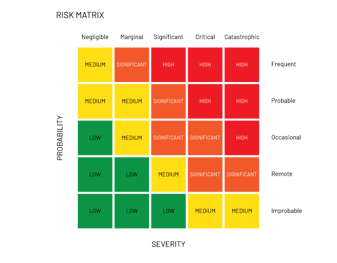
In aviation safety risk management, the risk matrix is a critical tool for assessing and prioritizing hazards, enabling organizations to maintain a robust Safety Management System (SMS). For U.S.-based aviation operators, ensuring that the risk matrix aligns with the Federal Aviation Administration’s (FAA) risk assessment requirements, as outlined in 14 CFR Part 5 and associated guidance, is essential for regulatory compliance and effective safety management.
A compliant risk matrix not only satisfies FAA audits but also enhances decision-making and fosters a proactive safety culture.
This article provides aviation safety managers with a comprehensive guide to verifying that their risk matrix meets FAA standards, offering actionable steps, regulatory insights, and practical tips.
Understanding FAA’s Risk Assessment Requirements
The FAA’s SMS rule, codified in 14 CFR Part 5, mandates that certificated operators (e.g., airlines, repair stations, and training organizations) implement an SMS that includes risk management processes. The risk matrix is a core component of these processes, used to evaluate hazards based on severity (the potential impact) and likelihood (the probability of occurrence). The FAA’s requirements for risk assessment are detailed in:
-
14 CFR Part 5.55: Requires operators to develop processes for analyzing safety risks, including a method to assess severity and likelihood.
-
FAA Advisory Circular (AC) 120-92B: Provides guidance on SMS implementation, emphasizing that risk assessments must be systematic, repeatable, and tailored to the organization’s operations.
-
FAA Order 8040.4C: Outlines risk management principles, including the need for clear severity and likelihood criteria and consistent risk categorization.
-
SMS Voluntary Program (SMSVP) Standard: Offers templates and tools, such as the SMS Gap Analysis Tool, to help operators align their risk matrices with FAA expectations.
To meet FAA requirements, a risk matrix must:
-
Be Systematic: Use a structured, repeatable methodology.
-
Define Clear Criteria: Specify severity and likelihood levels relevant to the organization.
-
Support Decision-Making: Categorize risks (e.g., low, medium, high) to guide mitigation priorities.
-
Be Tailored: Reflect the operator’s size, complexity, and risk profile.
-
Ensure Compliance: Align with regulatory standards and withstand FAA audits.
Verifying compliance involves a multi-step process of reviewing, testing, and documenting the risk matrix. Below, we outline how aviation safety managers can ensure their risk matrix meets FAA standards.
Related Articles on Aviation SMS Risk Matrix
- What Is a Risk Matrix and Risk Assessment in Aviation SMS
- How to Define Severity and Likelihood Criteria on Your Risk Matrix
- How to Create Your Risk Matrix for Risk Assessments in Aviation SMS
Why Verifying Compliance Is Critical
A risk matrix that meets FAA requirements offers several benefits:
-
Regulatory Compliance: Avoids findings during FAA audits or SMSVP evaluations.
-
Enhanced Safety: Ensures accurate risk prioritization, reducing the likelihood of incidents.
-
Operational Efficiency: Optimizes resource allocation by focusing on high-priority risks.
-
Stakeholder Confidence: Demonstrates a commitment to safety, reassuring regulators, employees, and customers.
-
Audit Readiness: Prepares operators for FAA oversight, including SMS assessments under Part 5.
Failure to comply can result in audit findings, mandatory corrective actions, or delays in SMSVP acceptance, undermining safety and operational credibility. Let’s explore the steps to verify compliance.
Steps to Verify Your Risk Matrix Meets FAA Requirements
Step 1: Review FAA Guidance and Standards
Start by familiarizing yourself with the FAA’s risk assessment requirements to establish a compliance baseline.
-
Key Documents:
-
14 CFR Part 5: Focus on Subpart C (Safety Risk Management), particularly §5.55, which requires a risk assessment process.
-
AC 120-92B: Review Appendix 1 for guidance on risk management processes, including risk matrix design.
-
FAA Order 8040.4C: Study the risk assessment framework, which emphasizes clear definitions and consistent application.
-
SMSVP Standard: Access the SMSVP Guide on the FAA website (faa.gov) for practical examples of compliant risk matrices.
-
-
Core Requirements:
-
The risk matrix must define severity and likelihood criteria.
-
Risk levels (e.g., low, medium, high) must trigger specific actions (e.g., monitoring, mitigation).
-
The process must be documented and repeatable.
-
The matrix must be tailored to the operator’s operations.
-
Action Item: Download the SMS Gap Analysis Tool from the FAA’s SMS website to assess your risk matrix against regulatory standards.
Step 2: Evaluate Risk Matrix Structure
Ensure the risk matrix is systematically designed to meet FAA expectations.
-
Matrix Design:
-
Use a grid (e.g., 3x3, 4x4, or 5x5) that plots severity (rows) against likelihood (columns).
-
Assign risk levels (e.g., low, medium, high) with clear action thresholds.
-
Example: A 5x5 matrix might categorize “catastrophic severity, frequent likelihood” as “high risk” requiring immediate action.
-
-
Severity Criteria:
-
Define levels (e.g., negligible, minor, moderate, major, catastrophic) based on potential consequences, such as injuries, aircraft damage, or operational disruption.
-
Example: “Major” might mean “multiple injuries or repair costs exceeding $500,000.”
-
-
Likelihood Criteria:
-
Define levels (e.g., improbable, remote, occasional, probable, frequent) based on probability, using qualitative or quantitative measures.
-
Example: “Probable” might mean “occurs once per year based on historical data.”
-
-
Color Coding: Use visual aids (e.g., green for low, yellow for medium, red for high) to enhance clarity.
Verification Checklist:
-
Are severity and likelihood criteria clearly defined?
-
Does the matrix use a consistent, repeatable structure?
-
Are risk levels linked to specific actions (e.g., “high risk requires mitigation within 24 hours”)?
Resource: Use the FAA’s SMS Implementation Guide for sample risk matrix templates.
Step 3: Tailor Criteria to Your Operation
The FAA requires the risk matrix to reflect the operator’s size, complexity, and risk profile, as outlined in AC 120-92B.
-
Size and Complexity:
-
Small Operators (e.g., single-pilot charters): Use a simple 3x3 matrix with basic criteria. Example: “Catastrophic” might mean “loss of aircraft,” and “frequent” might apply to common hazards like weather delays.
-
Large Operators (e.g., airlines): Use a 5x5 matrix with detailed criteria. Example: “Catastrophic” might include “loss of aircraft and reputational damage,” and “frequent” might apply to high-traffic risks like runway incursions.
-
-
Risk Profile:
-
Identify hazards specific to your operation using historical data, incident reports, and stakeholder input.
-
Example: An airport in a bird migration path might define “frequent” likelihood for bird strikes, while a cargo operator prioritizes “load shift” risks.
-
-
Customization:
-
Align severity with operational impacts (e.g., downtime, passenger volume).
-
Base likelihood on environmental factors (e.g., weather, traffic density) and historical trends.
-
Verification Tip: Document how criteria reflect your operation (e.g., “Severity levels are based on fleet size and passenger capacity”) to demonstrate compliance during FAA audits.
Step 4: Test the Risk Matrix with Scenarios
Apply the risk matrix to real and hypothetical scenarios to ensure it produces consistent, actionable results, as required by FAA Order 8040.4C.
-
Historical Scenarios:
-
Use past incidents (e.g., a runway excursion or maintenance error) to test the matrix.
-
Example: Assess a “bird strike causing engine damage” to verify if it’s rated appropriately (e.g., “major severity, occasional likelihood”).
-
-
Hypothetical Scenarios:
-
Test emerging risks, such as drone encounters or extreme weather events.
-
Example: Evaluate a “thunderstorm-related go-around” to confirm the matrix aligns with operational priorities.
-
-
Consistency Check:
-
Have multiple team members assess the same scenario to ensure consistent ratings.
-
Example: If two safety officers rate a “taxiway collision” differently, refine criteria for clarity.
-
Verification Checklist:
-
Does the matrix accurately categorize risks based on scenarios?
-
Are results consistent across users?
-
Do high-risk ratings trigger appropriate actions (e.g., immediate mitigation)?
Tool: Use SKYbrary’s Safety Management Toolkit (skybrary.aero) for scenario-based testing templates.
Step 5: Engage Stakeholders
Involve operational staff to ensure the risk matrix is practical and relevant, aligning with FAA’s emphasis on stakeholder engagement in AC 120-92B.
-
Stakeholder Input:
-
Gather feedback from pilots, maintenance crews, dispatchers, and managers.
-
Example: Pilots might suggest refining “likelihood” criteria for weather-related risks based on regional patterns.
-
-
Training:
-
Educate staff on the matrix using real-world examples.
-
Example: Show how a “fuel contamination” hazard is assessed to encourage accurate reporting.
-
-
Feedback Loop:
-
Collect user feedback to identify usability issues, such as overly complex criteria.
-
Example: If ground staff find severity definitions unclear, simplify terminology.
-
Verification Tip: Document stakeholder involvement (e.g., “Pilots reviewed matrix on [date]”) to demonstrate compliance during FAA audits.
Step 6: Document the Risk Matrix Process
The FAA requires documented processes to ensure repeatability and auditability, as per 14 CFR Part 5.53.
-
Documentation Components:
-
Risk Matrix Description: Detail the structure, criteria, and risk levels.
-
Customization Rationale: Explain how the matrix reflects your operation’s size, complexity, and risk profile.
-
Testing Results: Record scenario tests and stakeholder feedback.
-
Action Protocols: Specify actions for each risk level (e.g., “Medium risk requires mitigation within 30 days”).
-
-
Storage:
-
Include the risk matrix in your SMS manual or safety policy.
-
Ensure accessibility to all relevant staff.
-
Verification Checklist:
-
Is the risk matrix fully documented?
-
Does documentation include customization and testing details?
-
Is the process accessible for FAA audits?
Resource: Use IATA’s SMS Implementation Guide (iata.org) for documentation templates.
Related Articles on SMS Implementation
- Why Should We Implement Aviation SMS?
- How to Create Aviation SMS Implementation Plan - With Templates
- Is Your Aviation SMS Implementation a Farce? - With Self Assessments
Step 7: Conduct Internal Audits
Perform internal audits to verify ongoing compliance, as required by 14 CFR Part 5.95 (Safety Assurance).
-
Audit Scope:
-
Review the risk matrix against FAA standards (e.g., Part 5, AC 120-92B).
-
Assess whether the matrix is consistently applied in risk assessments.
-
Verify that mitigation actions align with risk levels.
-
-
Audit Frequency:
-
Conduct annual audits or after significant operational changes (e.g., fleet expansion).
-
-
Audit Process:
-
Use a checklist based on FAA’s SMS Assurance Guide.
-
Involve cross-functional teams to ensure objectivity.
-
-
Corrective Actions:
-
Address gaps, such as unclear criteria or inconsistent scenario ratings.
-
Example: If audits reveal under-reporting of hazards, simplify the matrix or enhance training.
-
Verification Tip: Use the FAA’s SMS Assurance Guide to structure audits.
Step 8: Prepare for FAA Oversight
Anticipate FAA audits or SMSVP evaluations to ensure readiness.
-
Audit Preparation:
-
Compile documentation, including the risk matrix, testing results, and audit records.
-
Train staff to explain the matrix’s use and compliance.
-
-
Common FAA Focus Areas:
-
Clarity of severity and likelihood criteria.
-
Evidence of customization to the operation.
-
Consistency in application across scenarios.
-
Documentation of stakeholder engagement.
-
-
SMSVP Evaluation:
-
If participating in the SMSVP, submit the risk matrix as part of the SMS Implementation Plan.
-
Expect FAA feedback on alignment with the SMSVP Standard.
-
Action Item: Schedule a mock audit using the SMS Gap Analysis Tool to identify gaps before FAA oversight.
Step 9: Monitor and Update
Continuously improve the risk matrix to maintain compliance, as required by 14 CFR Part 5.97 (Continuous Improvement).
-
Regular Reviews:
-
Review the matrix annually or after operational changes (e.g., new routes, emerging technologies).
-
Example: Update likelihood criteria to reflect increased drone activity.
-
-
Emerging Risks:
-
Incorporate new hazards, such as climate-related weather events or cybersecurity threats.
-
-
Feedback Integration:
-
Use audit findings and staff feedback to refine criteria.
-
Example: If pilots report that “remote” likelihood is too vague, add quantitative measures like “once every 5 years.”
-
Tip: Follow #AviationSafety on X or join LinkedIn groups like "Aviation Safety Management Systems" or “Aviation Safety Professionals” for updates on FAA guidance and industry best practices.
Challenges and Solutions
Verifying compliance can present challenges. Here’s how to address common issues:
-
Challenge: Lack of clarity in FAA requirements.
-
Solution: Cross-reference 14 CFR Part 5, AC 120-92B, and the SMSVP Guide for clarity, and consult FAA’s SMS website for FAQs.
-
-
Challenge: Difficulty tailoring the matrix.
-
Solution: Use historical data and stakeholder input to define criteria, and adapt FAA or IATA templates.
-
-
Challenge: Inconsistent scenario ratings.
-
Solution: Conduct training and scenario testing to ensure consistency, and simplify criteria if needed.
-
-
Challenge: Limited resources for small operators.
-
Solution: Leverage free FAA tools (e.g., SMS Gap Analysis Tool) and focus on high-impact risks.
-
Conclusion
Verifying that your risk matrix meets FAA’s risk assessment requirements is a critical task for aviation safety managers. A compliant risk matrix ensures regulatory adherence, enhances safety, and supports efficient resource allocation.
By reviewing FAA guidance, evaluating matrix structure, tailoring criteria, testing scenarios, engaging stakeholders, documenting processes, auditing internally, preparing for oversight, and continuously improving, you can build a risk matrix that meets FAA standards and strengthens your SMS.
Start by assessing your current risk matrix against 14 CFR Part 5 and AC 120-92B. Leverage FAA resources, such as the SMS Implementation Guide, and industry tools from SKYbrary or IATA. Involve your team to ensure practical application and maintain rigorous documentation for audit readiness.
With a verified risk matrix, you’ll uphold FAA compliance, protect your operation, and reinforce a culture of safety in the dynamic aviation industry.
Come to SMS Pro if you want the easy way out. We have an easily configurable risk matrix for you, and our tech support is always here to provide guidance.







